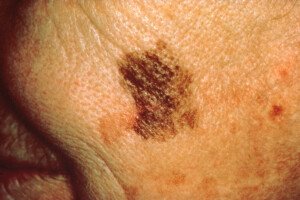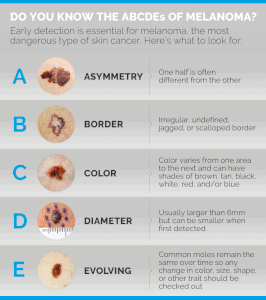
If melanoma is caught early enough, it’s highly curable, but many people let it slip by, and this is how this deadly skin cancer can get past even health-conscious people.
Two ways that this can happen stand out to Dr. Janet Prystowsky, board certified dermatologist in New York, NY, with 30+ years’ experience.
“One way is that a change noted in a mole has already gone too far by the time you seek attention,” begins Dr. Prystowsky.
“For instance, when a melanoma is already bleeding at the time of diagnosis, it has ulcerated and the risk is high that the melanoma has already metastasized.
“Even determination of the actual thickness of the melanoma [in the case of a bleeding one], an important factor in assessing the risk of the melanoma, is compromised because the top of it has been destroyed.”
Appearance
“The second way is that some melanomas do not look like the usual pictures of melanoma and they can grow quickly,” continues Dr. Prystowsky.

Melanoma on a cheek
“This nodular type of melanoma may have no brown or black color and may look like a pink to reddish bump on the skin.
“Usually the only reason for testing it is that it is a new bump or it may resemble a basal cell carcinoma; the biopsy result for doctor and patient is typically a surprise.
“Nodular melanoma can be particularly deadly because it is capable of metastasizing from the beginning of its existence.
“An early diagnosis and treatment does not guarantee a cure. Approximately 15% of all melanomas are in this category and it is very bad luck for the patient.”
Spread
“Once melanoma has metastasized, regardless of the original type of melanoma, it has spread to lymph nodes or other organs.
“This is very serious because it may cause death.
“There are several new treatment advances which can now put metastatic melanoma into remission, but they do not work on all patients.”
Prevention and Screening
Dr. Prystowsky stresses the importance of avoiding excessive sun exposure and avoiding tanning beds; using a sunscreen with an SPF of at least 30 and getting regular clinical skin exams by a dermatologist.
She recommends the ABCDEs:
Dr. Prystowsky explains that “A stands for asymmetry, as in a lopsided appearance to the mole.
“B stands for border irregularity of the mole, as in the appearance of the coast of Maine on a map.
“C stands for colors that are not uniform in the mole or a color change.
“D stands for the diameter of the mole. If the mole is over 6 mm in diameter, the risk is greater that the mole is abnormal.
“E stands for evolving because a mole that is changing such as itching, bleeding or showing other new symptoms suggests a possibility of melanoma.
“Because about 50% of melanomas arise in a pre-existing mole, seeing these changes in a mole should prompt a visit to the dermatologist.”


In combination with her focus on early skin cancer detection and removal, Dr. Prystowsky provides a wide range of revitalizing and rejuvenating treatments.
 Lorra Garrick has been covering medical, fitness and cybersecurity topics for many years, having written thousands of articles for print magazines and websites, including as a ghostwriter. She’s also a former ACE-certified personal trainer.
Lorra Garrick has been covering medical, fitness and cybersecurity topics for many years, having written thousands of articles for print magazines and websites, including as a ghostwriter. She’s also a former ACE-certified personal trainer.
.









































